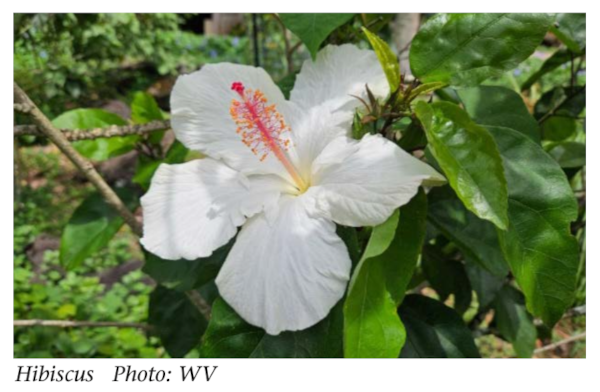By Kelsey Wheeler, Horticultural Field Supervisor,
Waimea Valley.
Here at Waimea Valley, we have several botanical collections that are devoted especially to native Hawaiian plants. My personal favorite is our “Hawaiian Flora A”, the garden surrounding our second pond. This garden showcases many endemic and indigenous species, with a couple of canoe plants as well. Many of the species grown in Hawaiian A were used by the Hawaiian people for medicine, food, dyes, and other cultural purposes.
Hawaii is home to five species of endemic hibiscus, all of which we have on display. Hibiscus brackenridgei, H. clayi, H. kokio, H. waimeae and H. arnottianus are our native hibiscus species: yellow, red and white blossoms, respectively. H. brackenridgei, the ma‘o hau hele, is our state flower, and it is also the only winter-blooming species. Our other hibiscuses bloom throughout the year, but ma‘o hau hele waits for the rains to arrive before blessing us with blossoms. H. kokio and H. clayi are ourtwo red hibiscus species, both of which were used for lei making. The leaves of H. kokio were used in lāʻau lapaʻau (traditional Hawaiian medicine): leaves were chewed and eaten as a laxative, and the juice was mixed with other plants and used to purify blood. H. waimeae and H. arnottianus are our two white blossoms and they are the only native hibiscus that have fragrance.
Many native Hawaiian plants were given names that reflect some other aspect of nature or life. ‘Āweoweo (Chenopodium oahuense) is one such plant, a small shrub that shares a name with a brightly colored reef fish. This endemic species has stems that are bright red in color, which is part of the reason for its name. Certain varieties of ‘āweoweo have leaves that, when crushed, give off a pungent aroma of fish, which is the other reason for the name. Pōhinahina (Vitex rotundifolia) was named for its silvery colored leaves; many plants that have a silvery or grey sheen will have “hina” in the name. Pōhinahina is a fairly common plant both in the Valley and throughout the islands and is increasingly used in landscaping. It has small purple flowers, used in lei making, and the edible leaves were used to relieve headaches and nausea.
We have several culturally important trees growing in Hawaiian A, including one of the most famous of native plants – Acacia koa, known in Hawaiian simply as koa. The wood from this tree is extremely strong and durable, and was particularly prized by Hawaiians for making canoes, paddles, and house posts. The bark was also used to dye kapa/tapa. With a slightly different name, the kou tree (Cordia subcordata), is another tree prized for its wood; however, this wood had different uses. Kou wood was used for making calabashes (food and water storage units), as well as bowls, plates and utensils. The reason for this is that the kou wood does not impart any resin flavor into the food; by comparison, koa wood has a strong sap that would leach into your food and change the flavor.
My own journey at Waimea Valley began in the Hawaiian A garden, so it holds a special place in my heart, and it has been a source of much learning and joy for me over the last few years. I’ve learned so much from the plants we have represented in Hawaiian A, and as I continue to learn I hope to share this love with the community. Waimea Valley offers a botanical tour every day of the week at 12:30 PM, where we walk through the first few gardens and give you fun facts about the plants we pass by. Each day of the week is hosted by a different member of our staff, and we always go through the Hawaiian A garden. Our mālama mala and ʻohana volunteer days are also good oportunities to work with our plant collections. Visit our website to reserve your spot at waimeavalley.net/volunteers and join us to learn more about our native plants!



